- Blog
- Agentic Experience
- Generative AI
- Personalization
- 11 min read
What Is Agentic Personalization: Guide on AI in Action!
Published
16 May 2025Updated
9 September 2025

Key Takeaways
- Agentic personalization is transforming eCommerce with AI agents that adapt shopping experiences in real time, like digital assistants for each shopper.
- Smart personalization moves beyond fixed rules, using real-time user behavior to deliver personalized experiences that adapt as shoppers browse.
- Unlike traditional methods that rely on static rules, autonomous personalization learns and adapts continuously, creating stronger customer connections and boosting conversions.
- Experro’s platform simplifies seamless, scalable personalization with agentic AI-powered search and recommendations.
The future of personalization is agentic.
Here’s our observation about agentic personalization:
What online shoppers often get today:
- Basic category filters
- “People also bought” carousels
- One-size-fits-all recommendations
What they now expect instead:
- Lightning-fast results
- Hyper-relevant suggestions
- Intuitive, personalized journeys
- Experiences that feel smart, not static
What delivers that experience in eCommerce?
👉 Agentic personalization!
AI that adapts, learns, and acts in real time — creating shopping journeys that truly connect.
What Is Agentic Personalization?
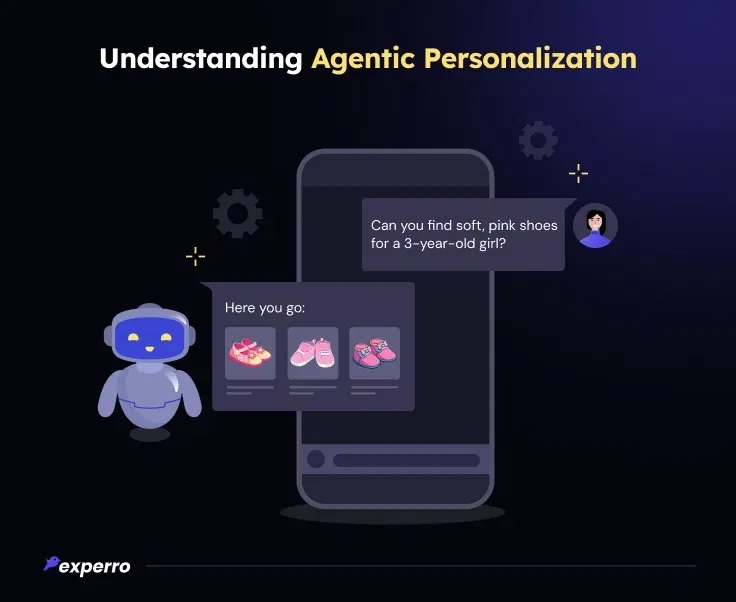
Agentic Personalization is a next-generation approach that uses autonomous agents to deliver highly personalized, context-aware experiences to individual users in real-time.
Unlike traditional personalization methods that rely on static rules or simple behavioral tags, this model leverages large language models as AI-driven decision-makers that constantly learn from user behavior, signals, and preferences.
Agentic Personalization = Adaptive Personalization
In simpler terms, it’s a system where AI agents independently curate experiences instead of waiting for user input. These agents operate on goals like improving conversions or increasing engagement and take actions like reshuffling product listings, changing content blocks, or recommending new categories to explore.
This makes agentic personalization in eCommerce more adaptive, scalable, and effective in meeting both user intent and business goals.
Unlike traditional methods, agentic AI systems don’t wait for inputs, they proactively guide each customer journey based on intent, behavior, and context.
By leveraging AI agent trends, brands can deliver real-time, ultra-personalization that adapts across channels and sessions, boosting engagement, relevance, and conversions.
In fact, 71% of consumers are more likely to purchase from brands that offer personalized experiences, highlighting the critical role of personalization in driving conversions.
To truly understand its impact, let’s compare adaptive experience personalization with traditional personalization approaches.
Comparing Agentic Personalization vs Traditional Personalization
While traditional personalization focuses on pre-set rules and reactive experiences, agentic personalization for online retailers uses AI-driven logic to create proactive, adaptive engagements.
Here's a clear comparison:
| Point of Difference | Traditional Personalization | Agentic Personalization |
|---|---|---|
| Approach | Rule-based, reactive | AI-driven, proactive |
| Adaptability | Static experiences | Learns & adapts in real-time |
| User Input | Waits for behavior and prompts | Predicts behavior and performs action |
| Scalability | Manual configurations | Scales automatically through autonomous decisions |
| Channel Coverage | Fragmented | Unified omnichannel delivery |
How Does Agentic Personalization Work?
The agentic personalization begins with intelligent agents embedded within your digital e-store. These intelligent agents observe user behavior, extract patterns, and take actions autonomously to optimize the journey in real time.
AI-orchestrated personalization relies on an intelligent stack of technologies that combine to personalize every customer interaction. These systems aren’t just reactive, they’re proactive, predictive, and self-improving — exactly how Experro’s Gen AI-powered personalization engine is redefining modern commerce.
From real-time behavior capture to adaptive learning loops, here’s a breakdown of the core technologies powering agentic personalization:
| Layer | Technology/Method | Role/Usage | Example (Customer B) |
|---|---|---|---|
| Core Engine | Reinforcement Learning (RL) | Sequence optimal actions across sessions to meet goals. | How should I plan future offers for Customer B to maximize sales? |
| Contextual Bandits | Choose the best next action based on immediate context. | Which product suits Customer B’s current browsing? | |
| Multi-Agent Systems | Assign tasks to specialized agents for different decisions. | Which agent—explore, exploit, update—should act now? | |
| Dynamic Goal Prioritization | Rebalance personalization objectives in real-time. | Should I prioritize engagement or upsell for Customer B today? | |
| Data Layer | Streaming Platforms (Kafka, Flink) | Continuously ingest real-time customer interactions. | Capture Customer B’s sneaker browsing instantly. |
| Real-Time Profiling (Embeddings) | Continuously evolve customer profiles from signal inputs. | Update Customer B’s preferences from T-shirts to sneakers. | |
| Event-Based Triggers | Enable system reactions based on key behavioral milestones. | Trigger a discount when Customer B lingers on a product page. | |
| Adaptation Layer | Active Learning Systems | Identify gaps and adapt by testing unfamiliar inputs. | Test new categories to learn Customer B’s evolving taste. |
| Confidence Scoring | Quantify certainty in predictions to guide exploration. | If unsure, should I explore or stick to known interests? | |
| Explainable AI (XAI) | Offer transparency into recommendation logic. | Explain why Customer B’s recommendations shifted. | |
| Feedback Loops | Refine models with continuous user reactions. | Did Customer B click, ignore, or convert after the suggestion? |
Now that we are aware of the key technologies driving the dynamic evolution of personalization, let’s learn more about one of its practical applications, like how AI-driven cookies are changing the customer experience today.
How Are AI-Driven Cookies Changing the Customer Experience Today?
The less usage of third-party cookies gave rise to smarter, more privacy-conscious innovations and AI-driven cookies are leading that charge.
These modern solutions use AI to infer and learn preferences based on real-time behavior, not just stored history. They track nuanced interactions like dwell time, click frequency, or hesitations, enabling real-time AI content personalization agents to craft deeply tailored experiences.
In short, cookies make agent-based personalization feel more human and much less creepy by responding to context rather than tracking identity.
- For brands, it means smarter engagement.
- For users, it means a more seamless, delightful digital shopping experience.
As these cookies evolve, they don’t just show relevant products—they learn from each shopper and help create a smarter, more personal experience every time.
What Are the Examples of Agentic AI Personalization?
Let’s break down the applications of adaptive Personalization with some real-world examples:
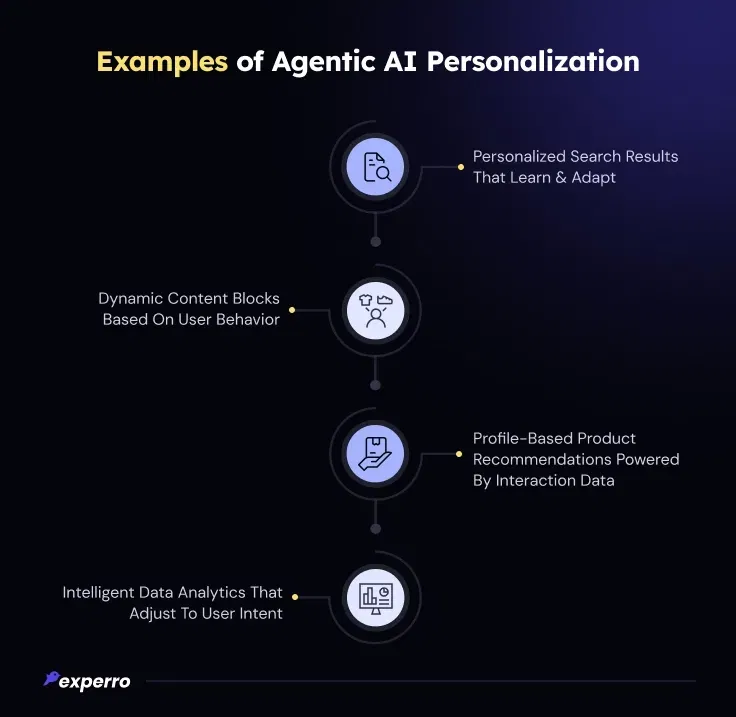
1. Personalized Search Results That Learn and Adapt
Agentic AI personalization examples include search bar user interfaces that evolve. AI refines results over time as users interact, showing products, that better match inferred preferences.
If someone regularly searches for “affordable wedding rings”, next time they type “rings”, budget-friendly options surface first. This active learning model improves relevance and retention.
2. Dynamic Content Blocks Based on User Behavior
Imagine a personalized landing page and homepage that re-shapes itself in real-time. New visitors see bestsellers. Repeat users see “Inspired by your last visit” blocks. These adaptive-orchestrated personalization applications enhance journey fluidity (smooth progression across touchpoints).
AI dynamically arranges modules, whether promotions, reviews, or stories to maximize customer engagement and drive emotional connection.
3. Profile-Based Product Recommendations Powered by Interaction Data
Forget “customers also bought”. Personalize with agentic AI using deep behavioral profiles. These recommendations understand not just what’s clicked but what’s ignored, hovered over, or compared.
This yields gen AI-powered suggestions that convert better and feel naturally helpful.
4. Intelligent Data Analytics That Adjust to User Intent
Conversational AI agents don’t just personalize; they also analyze intent and connect with the users. From click trails to session durations, Agentic AI redefines LLM-powered personalization by converting data into action.
Through real-time feedback, the agentic merchandising assistant quietly fine-tunes merchandising and content, delivering a personalized experience without disrupting the user journey.
After learning about all the examples, let’s jump into the advantages of autonomous personalization.
Want to turn customer intent into sales?
Make way for Experro’s Agentic personalization in your e-store!
What Are the Benefits of Agent-Based Personalization In Commerce?
Now that we understand the mechanics, let’s explore why eCommerce brands should apply agentic personalization.
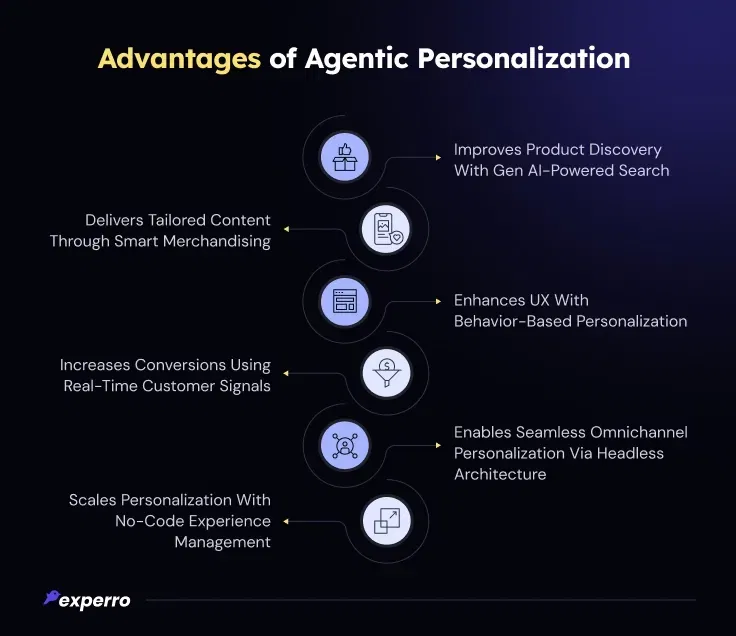
Here’s how agent-based personalization changes the game:
1. Improves Product Discovery with Generative AI-Powered Search
Agentic AI search doesn’t just match keywords, it understands intent. By integrating gen AI into search functions, agentic personalization for retail enables intelligent query re-writing, typo-tolerance, and context-aware suggestions.
Instead of navigating menus, customers simply describe what they want in natural language. Agents interpret those needs and present hyper-relevant results. This reduces friction and boosts engagement from the very first click.
ROI of agentic personalization for B2C brands begins right here—with better, faster discovery.
2. Delivers Tailored Content Through Smart Merchandising
Agentic AI-powered digital merchandising means your homepage, category pages, and banners dynamically adapt for each individual shopper—not universally but based on who’s browsing. Think adaptive storytelling where what’s shown to a new visitor is different from what a returning VIP sees.
By tracking behavior and context in real-time, AI agent personalization techniques re-arrange elements to maximize impact without manual configuration. This kind of real-time AI content personalization agent transforms passive browsing into active engagement.
3. Enhances UX With Behavior-Based Personalization
A one-size-fits-all UX doesn’t work anymore. Agentic personalization in eCommerce makes your storefront feel intuitive. How? By adapting layouts, content blocks, profile-based recommendations and even CTAs based on how users interact.
Whether it is adjusting navigation based on scroll depth or switching themes for returning customers, AI agents tailor the customer experience moment-by-moment, creating a truly responsive, personal environment.
4. Increases Conversions Using Real-Time Customer Signals
Agentic AI and hyper-personalization combine to turn micro-moments into conversions. Agents intervene in real time by analyzing behavior like hesitation, clicks, or comparison patterns.
They might trigger a limited-time offer, a nudge about low inventory, or even a chatbot that can personalize customer interactions based entirely on live intent. This responsive flow dramatically improves conversion metrics and cart completion rates.
5. Enables Seamless Omnichannel Personalization via Headless Architecture
AI agents for personalization can deliver consistent experiences across every digital touchpoint, from mobile apps to kiosks and web stores, with the help of headless architecture.
This enables seamless omnichannel personalization that doesn’t just reuse data, it intelligently adapts for each channel to match context and user behavior. Your customer might browse on mobile and convert on desktop, but the experience feels continuous and unified, driven by intelligent, agentic personalization tools for online stores.
6. Scales Personalization with No-Code Experience Management
Traditional personalization strategies are hard to scale. But with no-code agentic experience platforms for personalization, marketers and merchandisers can launch new experiences without writing a single line of code.
This makes implementing agentic personalization strategies faster and easier, allowing brands to keep up with real-time demand, seasonality, or behavior shifts, all from a centralized console.
After learning all the benefits, let’s dive deeper into the hurdles of implementing adaptive experience personalization in eCommerce in the next section.
Challenges of Implementing Agentic Personalization in eCommerce
Despite the benefits, challenges of agentic personalization in eCommerce can’t be ignored:
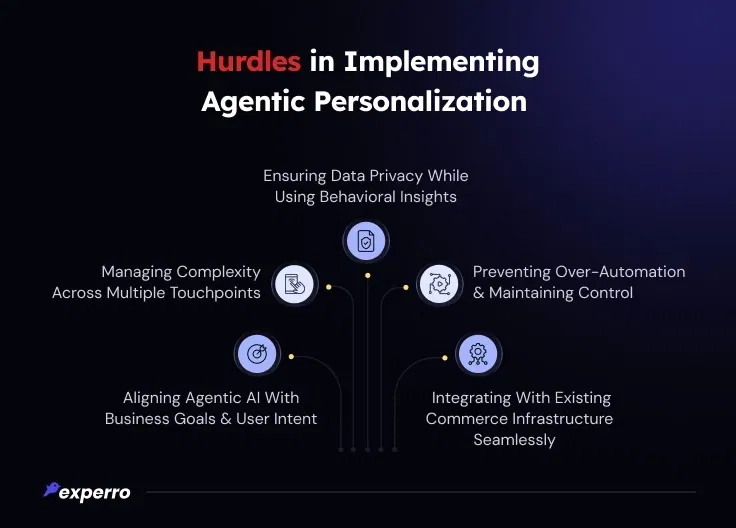
1. Aligning Agentic AI With Business Goals and User Intent
Agents may act independently, but without aligned goals, they risk pursuing metrics over meaning. It's critical to frame AI objectives around both customer loyalty and business ROI.
Even the smartest agent is ineffective if it lacks a clear, business-aligned purpose.
However, Experro enables gen AI personalization powered by real-time customer behavior and business rules for aligned outcomes.
2. Managing Complexity Across Multiple Touchpoints
As personalization spreads across devices, ensuring consistent behavior becomes complex. AI agents must understand the user’s context across sessions and channels.
Gaps in synchronization can create jarring experiences that frustrate users and reduce trust. Seamless orchestration is no longer optional, but it's expected.
To tackle this, Experro unifies experiences across mobile first eCommerce websites, and kiosk with centralized data and intelligent journey orchestration.
3. Ensuring Data Privacy While Using Behavioral Insights
Customers expect a journey of personalization, but also demand privacy. Striking this balance is tough when collecting and using behavioral data. Missteps in data handling can damage brand reputation and violate regulations. Agentic AI must be privacy-conscious by design.
That’s why Experro offers built-in consent management and anonymization tools to balance personalization with compliance.
4. Preventing Over-Automation and Maintaining Control
Agents may deliver shopping experiences that feel impersonal or unpredictable. Guardrails, testing, and human overrides must be built-in. Blind automation without oversight risks alienating customers. Brands must always remain in the driver’s seat.
In response, Experro blends autonomy with oversight through customizable workflows and human-in-the-loop controls.
5. Integrating With Existing Commerce Infrastructure Seamlessly
Legacy systems often resist change. Integrating agentic personalization tools and technologies with older platforms can be resource intensive. Inflexible architecture can stall implementation and limit AI capabilities. Compatibility must be prioritized from the start.
To ease this, Experro’s API-first, headless architecture makes integration with legacy systems and modern stacks frictionless.
Blinds To Go x Experro: A Case Study in Agentic Personalization
Blindstogo.com chose Experro to help build fully functional personalized online experiences.
Experro helped them transform their eCommerce experience with personalized search, dynamic content delivery, and intelligent merchandising.
By leveraging Experro’s agentic platform, they created faster and more relevant user journeys that increased customer engagement.
The result? A smarter shopping flow that responded to each customer’s preferences in real-time!
Let Experro Help You Build User-Driven Journeys Through Agentic Personalization!
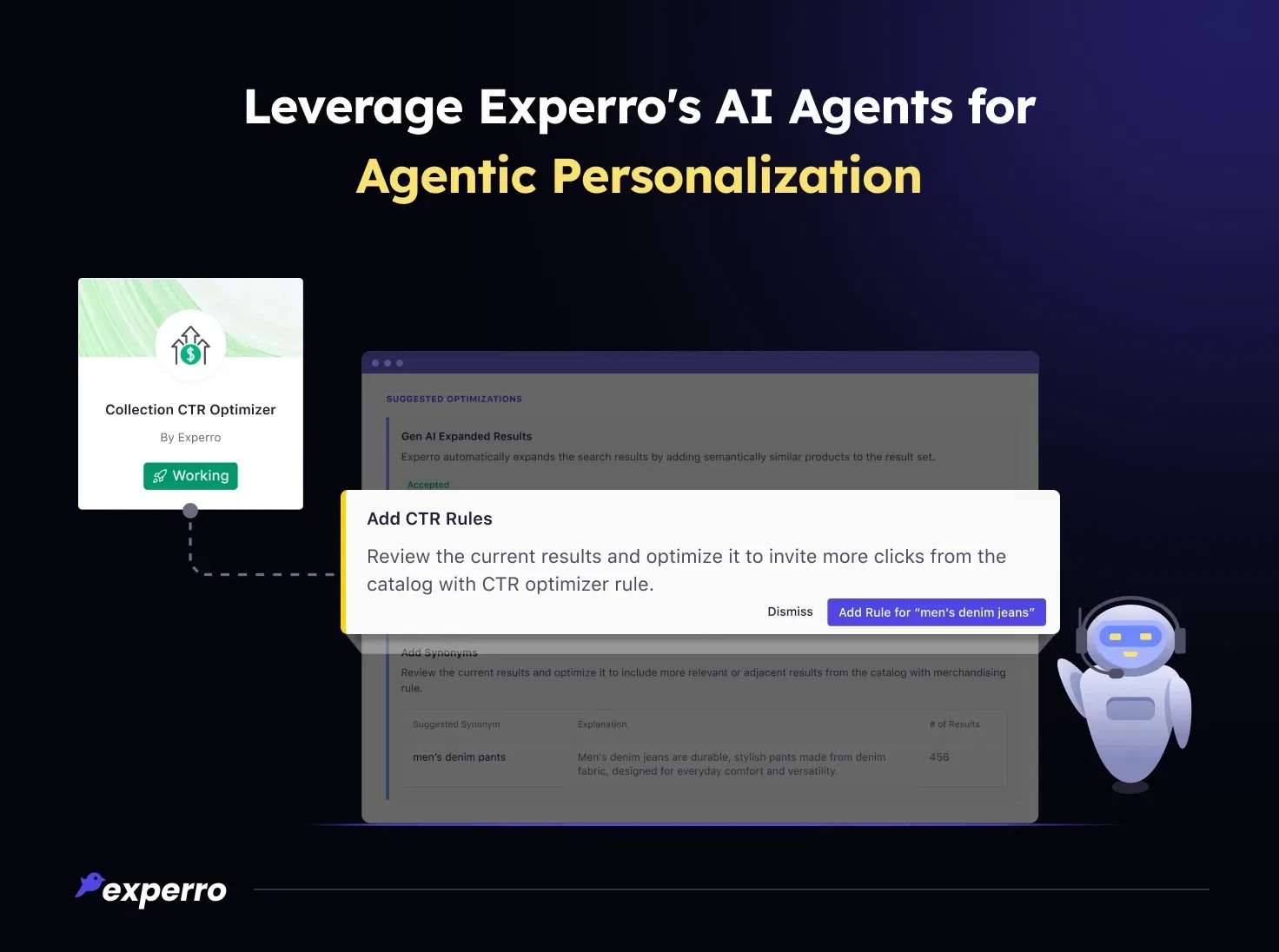
Experro helps you deliver personalized and agentic AI experiences, tailored to every customer in real time.
It starts with Gen AI-powered search that goes beyond keywords, i.e. understanding intent, context, and behavior to deliver highly relevant results instantly.
To complement that, our platform's personalization capabilities dynamically suggests products and promotions based on performance metrics and shopper actions.
Choosing an agentic commerce solution for personalized journeys allows you to build on the momentum of real-time, adaptive merchandising.
Together, these capabilities enable you to create faster, smarter, and more engaging eCommerce journeys that convert.
Make every customer journey count with Experro’s Agentic personalization!
Conclusion
Agentic personalization isn’t just another digital marketing trend but it’s the agentic future for personalization.
By enabling Agents to drive context-aware decisions, brands can offer seamless, intelligent, and relevant experiences at scale. For retailers, it means better ROI. For users, it means a better customer journey.
To stay competitive, eCommerce agentic personalization must be part of your roadmap. Connect with our experts on a call for a demo on how Experro makes this future possible today.
FAQs
Why use agentic personalization in eCommerce?
Agentic personalization delivers highly relevant, context-aware experiences that evolve with each shopper's behavior.
Unlike static personalization, it adapts in real time, making product discovery faster, content more engaging, and journeys more seamless.
This leads to higher conversions, reduced bounce rates, and better alignment with today’s dynamic customer expectations.
What are examples of agentic personalization?
Agentic personalization in eCommerce involves AI systems that act autonomously on behalf of users to deliver adaptive, real-time experiences.
Common examples include:
-
Adaptive search results that get re-arranged based on each shopper’s intent and behavior.
-
AI algorithms personalize content and reshuffle on category or product pages, based on customer engagement patterns.
-
Behavior-based product recommendations which evolve as users click, browse, or add to cart
-
Predictive content blocks that dynamically change messaging or offer depending on where the user is in the funnel.
-
Context-aware navigation and filters that adjust based on previous sessions or known preferences
How does Experro support agentic personalization?
Experro supports AI agents in personalization through its full-stack platform combining AI-powered search, intelligent merchandising, and real-time, behavior-driven recommendations.
With a headless, API-first architecture and no-code controls, Experro enables teams to create personalized, scalable eCommerce experiences that adapt continuously across channels.
How does agentic personalization enhance user experience?
Agentic personalization makes user experiences more relevant by adapting in real-time. It responds to intent, behavior, and preferences—not just static data.
- Recommends products based on current user signals, not past segments.
- Adapts content and layout dynamically for each visitor.
- Reduces friction by anticipating needs and streamlining navigation.
- Learns continuously to improve future interactions.
Is agentic personalization better than rule-based personalization?
Yes, because it removes the rigidity of pre-defined rules.
While rule-based personalization relies on fixed conditions (like location or age), agentic personalization uses AI to understand user behavior and intent in real-time.
It adapts instantly without requiring manual input, making it far more scalable, flexible, and user centric.
What industries are using agentic personalization effectively?
Agentic personalization is gaining traction across industries where user intent, speed, and relevance matter the most.
Businesses that rely on digital experiences are leveraging it to deliver more adaptive, customer-first interactions.
- eCommerce – Tailored product recommendations and personalized search.
- Media & Entertainment – Dynamic content suggestions and viewer profiling based on interests.
- Travel & Hospitality – Personalized trip itineraries and booking flows for different customers.
- Finance – Real-time product offers based on user intent.
- Healthcare – Adaptive patient portals and resource suggestions.
How do I implement agentic personalization on my site?
Implementing agentic personalization starts with the right foundation. A platform like Experro makes it easy to bring real-time, AI-powered experiences to life, without the complexity of traditional setups.
Here are the steps to get started:
- Choose a platform that supports real-time, AI-driven personalization like Experro.
- Integrate your data sources (behavioral, transactional, contextual).
- Define goals: product discovery, engagement, conversion, etc.
- Start with key touchpoints—homepage, product pages, search results.
- Continuously monitor performance and refine based on insights.
Explain how agentic AI contributes to personalization at scale?
Agentic AI delivers personalization by autonomously adapting to each shopper’s behavior in real time.
For example, if a customer often buys eco-friendly clothing, it won’t just show similar items but curate outfits in their style. This makes every interaction feel personal, even across thousands of shoppers.
Pallavi Dadhich
Content Writer @ ExperroPallavi is an ambitious author recognized for her expertise in crafting compelling content across various domains. Beyond her professional pursuits, Pallavi is deeply passionate about continuous learning, often immersing herself in the latest industry trends. When not weaving words, she dedicates her time to mastering graphic design.
What's Inside
- What Is Agentic Personalization?
- Comparing Agentic Personalization vs Traditional Personalization
- How Does Agentic Personalization Work?
- How Are AI-Driven Cookies Changing the Customer Experience Today?
- What Are the Examples of Agentic AI Personalization?
- What Are the Benefits of Agent-Based Personalization In Commerce?
- Challenges of Implementing Agentic Personalization in eCommerce
- Blinds To Go x Experro: A Case Study in Agentic Personalization
- Let Experro Help You Build User-Driven Journeys Through Agentic Personalization!
- Conclusion
Subscribe to Our Newsletters
Get the latest insights delivered straight to your inbox.


